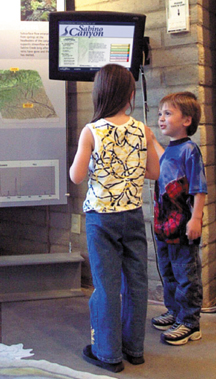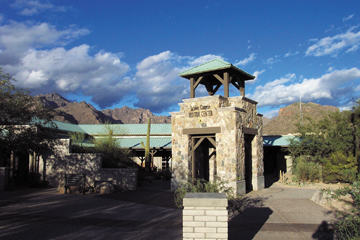
Geotimes Home | AGI Home | Information Services | Geoscience Education | Public Policy | Programs | Publications | Careers

 An
innovative outreach collaboration began with, of all things, wet feet. The Sabino
Canyon Recreation Area, located within the Coronado National Forest, Ariz., includes
a popular hiking trail that follows Sabino Creek for about 3.8 miles — garnering
more than 1.4 million visitors every year. Nine bridges span the creek along this
trail and are prone to frequent overflow during the rainy seasons. Consequently,
the visitors center at Sabino Canyon receives a large volume of telephone calls
from people asking: “How much water is flowing in Sabino Creek?” and
“Are the bridges safe to cross?”
An
innovative outreach collaboration began with, of all things, wet feet. The Sabino
Canyon Recreation Area, located within the Coronado National Forest, Ariz., includes
a popular hiking trail that follows Sabino Creek for about 3.8 miles — garnering
more than 1.4 million visitors every year. Nine bridges span the creek along this
trail and are prone to frequent overflow during the rainy seasons. Consequently,
the visitors center at Sabino Canyon receives a large volume of telephone calls
from people asking: “How much water is flowing in Sabino Creek?” and
“Are the bridges safe to cross?”  The
potential use and public awareness of these data have broadened tremendously.
Since the exhibits were installed in October 2002, visitors have been accessing
the exhibits almost nonstop during busy days. Peaks in Web site usage have coincided
with rainfall events.
The
potential use and public awareness of these data have broadened tremendously.
Since the exhibits were installed in October 2002, visitors have been accessing
the exhibits almost nonstop during busy days. Peaks in Web site usage have coincided
with rainfall events.  |
Geotimes Home | AGI Home | Information Services | Geoscience Education | Public Policy | Programs | Publications | Careers |